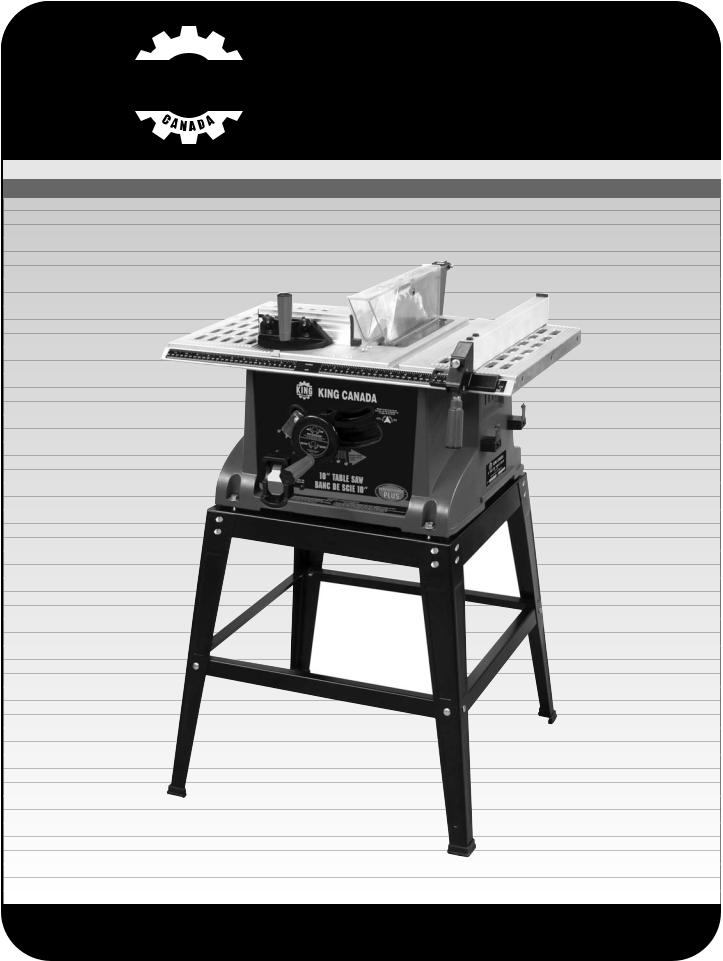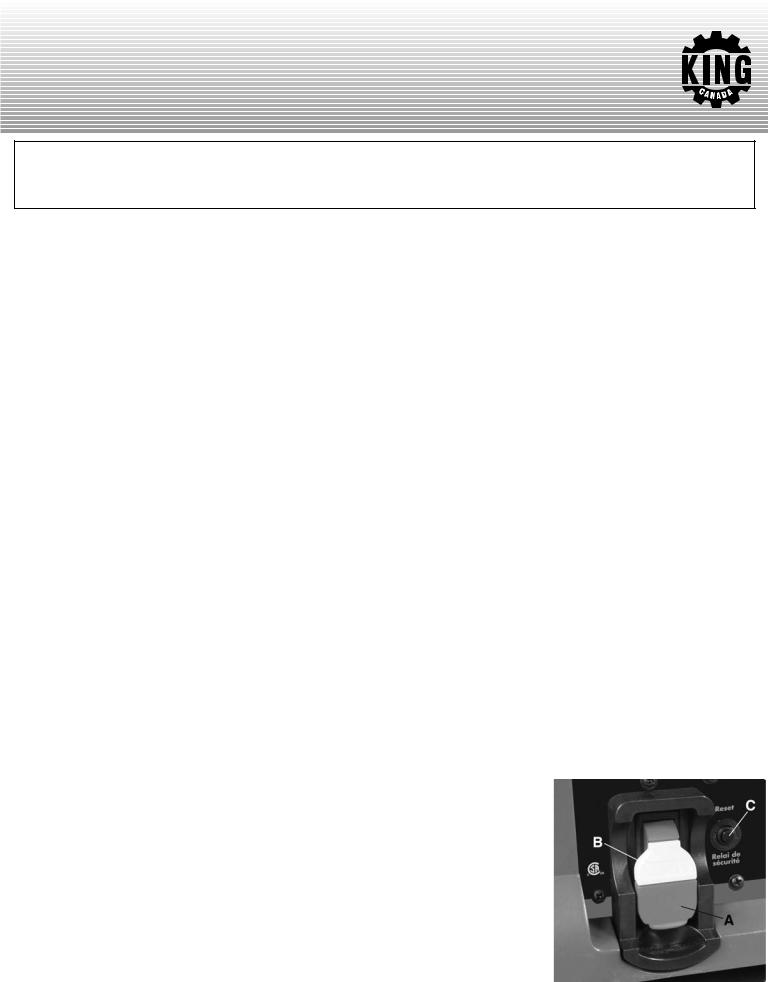King Canada KC-5004 User Manual




 KING CANADA
KING CANADA
10” TABLE SAW WITH STAND
MODEL: KC-5004
INSTRUCTION MANUAL
COPYRIGHT © 2009 ALL RIGHTS RESERVED BY KING CANADA TOOLS INC.

WARRANTY INFORMATION
2-YEAR |
KING CANADA TOOLS |
LIMITED WARRANTY |
OFFERS A 2-YEAR LIMITED WARRANTY |
FOR THIS 10” TABLE SAW |
FOR NON-COMMERCIAL USE. |
|
|
PROOF OF PURCHASE
Please keep your dated proof of purchase for warranty and servicing purposes.
REPLACEMENT PARTS
Replacement parts for this product are available at our authorized King Canada service centers across Canada.
LIMITED TOOL WARRANTY
King Canada makes every effort to ensure that this product meets high quality and durability standards. King Canada warrants to the original retail consumer a 2-year limited warranty as of the date the product was purchased at retail and that each product is free from defects in materials. Warranty does not apply to defects due directly or indirectly to misuse, abuse, normal wear and tear, negligence or accidents, repairs done by an unauthorized service center, alterations and lack of maintenance. King Canada shall in no event be liable for death, injuries to persons or property or for incidental, special or consequential damages arising from the use of our products.
To take advantage of this limited warranty, return the product at your expense together with your dated proof of purshase to an authorized King Canada service center. Contact your retailer or visit our web site at www.kingcanada.com for an updated listing of our authorized service centers. In cooperation with our authorized serviced center, King Canada will either repair or replace the product if any part or parts covered under this warranty which examination proves to be defective in workmanship or material during the warranty period.
KING CANADA INC. DORVAL, QUÉBEC, CANADA H9P 2Y4
www.kingcanada.com

GENERAL & SPECIFIC
SAFETY INSTRUCTIONS
1.KNOW YOUR TOOL
Read and understand the owners manual and labels affixed to the tool. Learn its application and limitations as well as its specific potential hazards.
2.GROUND THE TOOL.
This tool is equipped with an approved 3-conductor cord and a 3-prong grounding type plug to fit the proper grounding type receptacle. The green conductor in the cord is the grounding wire. NEVER connect the green wire to a live terminal.
3.KEEP GUARDS IN PLACE.
Keep in good working order, properly adjusted and aligned.
4.REMOVE ADJUSTING KEYS AND WRENCHES.
Form habit of checking to see that keys and adjusting wrenches are removed from tool before turning it on.
5.KEEP WORK AREA CLEAN.
Cluttered areas and benches invite accidents. Make sure the floor is clean and not slippery due to wax and sawdust build-up.
6.DON’T USE IN DANGEROUS ENVIRONMENT.
Don’t use power tools in damp or wet locations, or expose them to rain. Keep work area well lit and provide adequate surrounding work space.
7.KEEP CHILDREN AWAY.
All visitors should be kept a safe distance from work area.
8.MAKE WORKSHOP CHILD-PROOF.
-with padlocks, master switches or by removing starter keys.
9.DON’T FORCE TOOL.
It will do the job better and safer at the rate for which it was designed.
10.USE RIGHT TOOL.
Don’t force the tool or the attachment to do a job for which it was not designed.
11. USE PROPER EXTENSION CORD
Make sure the extension cord is in good condition. When using an extension cord, be sure to use one heavy enough to carry the current your tool will draw. An undersized cord will cause a drop in line voltage resulting in loss of power and overheating. See following page for table showing correct size to use depending on the cord lenght and the nameplate amperage rating. If in doubt, use the next heavier gauge. The smaller the gauge number, the heavier the cord.
12. WEAR PROPER APPAREL.
Do not wear loose clothing, gloves, neckties or jewelry (rings, watch) which may get caught in moving parts. Non-slip footwear is recommended. Wear protective hair covering to contain long hair. Roll up long sleeves above the elbows.
13. ALWAYS WEAR SAFETY GLASSES.
Also use a face or dust mask if cutting operation is dusty. Always wear safety glasses (ANSI Z87.1). Everyday eyeglasses only have impact resistant lenses, thet are NOT safety glasses.
14. SECURE WORK.
Use clamps or a vise to hold work when practical. It’s safer than using your hand and it frees both hands to operate tool.
15. DON’T OVERREACH.
Keep proper footing and balance at all times.
16. MAINTAIN TOOL WITH CARE.
Keep tools sharp and clean for best and safest performance.
Follow instructions for lubricating and changing accessories.
17. DISCONNECT TOOLS.
Before servicing, when changing accessories or attachments such as blades.
18. AVOID ACCIDENTAL STARTING.
Make sure the swich is in the ‘’OFF’’ position before plugging in.
19. USE RECOMMENDED ACCESSORIES.
Consult the manual for recommended accessories. Follow the instructions that accompany the accessories. The use of improper accessories may cause risk of injury to persons.
20. NEVER STAND ON TOOL.
Serious injury could occur if the tool tips over or if the cutting tool is unintentionally contacted. Do not store materials such that it is necessary to stand on the tool to reach them.
21. CHECK DAMAGED PARTS.
Before further use of the tool, a guard or other parts that are damaged should be carefully checked to ensure that they will operate properly and perform their intended function. Check for alignment of moving parts, binding of moving parts, breakage of parts, mounting, and any other conditions that may affect its operation. A guard or other parts that are damaged should be properly repaired or replaced.
22. DIRECTION OF FEED.
Feed work into blade or cutter against the direction of rotation of the blade or cutter only.
23. NEVER LEAVE MACHINE RUNNING UNATTENDED. TURN POWER OFF. Don’t leave any tool running until it comes to a complete stop.
SPECIFIC TABLE SAW SAFETY INSTRUCTIONS
1. AVOID KICKBACKS.
Avoid kickbacks by keeping the blade sharp, the rip fence parallel to the saw blade and by keeping the splitter and ant-kickback fingers and blade guard in place, aligned and functioning properly. Do not release work piece before passing it completely behond the saw blade. Do not rip a work piece that is twisted, warped or does not have a straight edge to guide it along the rip fence. Do not attempt to reverse out of a cut while the blade is still turning.
2. ALWAYS USE A PUSH STICK.
Always use a push stick, especially when ripping narrow work piece. One is supplied with this saw and a pattern for making a push stick is included in this manual.
3.REMOVE RIP FENCE.
Remove the rip fence when crosscutting.
4.NEVER USE RIP FENCE AS CUT-OFF GAUGE.
Never use the rip fence as a cut-off gauge when crosscutting.
5.NEVER ATTEMPT TO FREE A STALLED BLADE.
If a work piece stalls the blade, turn the saw off for safety and also to prevent damaging the motor.
6.NEVER CUT METALS.
Never cut metals or materials that may make hazardous dust.
7.MOUNT TABLE SAW.
Mount your table saw on the supplied stand or mount it to a work bench before performing any cutting operations.

ELECTRICAL INFORMATION
WARNING!
ALL ELECTRICAL CONNECTIONS MUST BE DONE BY A QUALIFIED ELECTRICIAN. FAILURE TO COMPLY MAY RESULT IN SERIOUS INJURY! ALL ADJUSTMENTS OR REPAIRS MUST BE DONE WITH THE TABLE SAW DISCONNECTED FROM THE POWER SOURCE. FAILURE TO COMPLY MAY RESULT IN SERIOUS INJURY!
POWER SUPPLY
WARNING: YOUR TABLE SAW IS WIRED AT THE FACTORY FOR 110-120V OPERATION, IT MUST BE CONNECTED TO A 110-120V/15-AMP. TIME DELAY FUSE OR CIRCUIT BREAKER. FAILURE TO CONNECT IN THIS WAY CAN RESULT IN INJURY FROM SHOCK OR FIRE. This table saw is intended for use on a electrical circuit that has an outlet and a plug which looks like the one illustrated in Fig.1.
WARNING: DO NOT USE A TWO-PRONG ADAPTOR FOR THEY ARE NOT IN ACCORDANCE WITH LOCAL CODES AND ORDINANCES. NEVER USE IN CANADA.
GROUNDING
GROUNDED OUTLET
CURRENT
CARRYING
PRONGS
GROUNDING PRONG
FIGURE 1
This table saw must be grounded. If it should malfunction or breakdown, grounding provides a path of least resistance for electric current, to reduce the risk of electric shock. This table saw is equipped with a cord having an equipment-grounding conductor and grounding plug. The plug must be plugged into an appropriate outlet that is properly installed and grounded in accordance with all local codes and ordinances. Do not modify the plug provided, if it will not fit the outlet, have the proper outlet installed by a qualified electrician. Not all outlets are properly grounded. If you are not sure if your outlet is properly grounded, have it checked by a qualified electrician.
Improper connection of the equipment-grounding conductor can result in risk of electric shock. The conductor with insulation having an outer surface that is green with or without yellow stripes is the equipment-grounding conductor. If repair or replacement of the power cord or plug is necessary, do not connect the equipment-grounding conductor to a live terminal.
Check with a qualified electrician or service personnel if the grounding instructions are not completely understood, or if in doubt as to whether the tool is properly grounded. Use only 3 wire extension cords that have 3-prong grounding plugs and 3 pole receptacles that accept the tool’s plug. Repair or replace damaged or worn cord immediately.
WARNING: IF NOT PROPERLY GROUNDED, THIS TABLE SAW CAN CAUSE ELECTRICAL SHOCK, |
Tool’s |
Cord Size in A.W.G. |
||||
PARTICULARLY WHEN USED IN DAMP LOCATIONS. TO AVOID SHOCK OR FIRE, IF THE POWER |
||||||
CORD IS WORN OR DAMAGED IN ANY WAY, HAVE IT REPLACED IMMEDIATELY. |
Amperage |
Cord Length in Feet |
||||
USE PROPER EXTENSION CORD |
Rating |
25 |
50 |
100 |
150 |
|
|
|
|
|
|
||
3-6 |
18 |
16 |
16 |
14 |
||
Make sure the extension cord is in good condition. When using an extension cord, be sure to use one |
||||||
6-8 |
18 |
16 |
14 |
12 |
||
heavy enough to carry the current your tool will draw. An undersized cord will cause a drop in line |
8-10 |
18 |
16 |
14 |
12 |
|
voltage resulting in loss of power and overheating. See Fig.2 for table showing correct size to use |
10-12 |
18 |
16 |
14 |
12 |
|
depending on the cord lenght and the nameplate amperage rating. If in doubt, use the next heavier |
12-16 |
14 |
12 |
- |
- |
|
gauge. The smaller the gauge number, the heavier the cord. Always use U.L. and CSA listed extension |
|
|
|
|
|
|
|
|
|
|
|
||
cords. |
|
FIGURE 2 |
|
|
||
WARNING: Replace damaged cords immediately. Use of damaged cords can shock, burn or electrocute.
ON/OFF SWITCH WITH REMOVABLE SAFETY KEY |
|
|
The On/Off switch (A) Fig.3 comes with a removable safety key (B). When the safety key is removed |
|
|
from the switch and placed in a safe location, unauthorized persons or children can’t turn the switch to |
|
|
the On position. It is recommended to always remove the safety key from the switch whenever the table |
|
|
saw is not in use. |
|
|
RESET BUTTON (OVERLOAD PROTECTOR) |
|
|
This table saw comes with an overload reset button (C) Fig.3 (next to the On/Off Switch). When the |
|
|
table saw motor overheats, a safety mechanism stops the motor automatically due to motor |
|
|
overheating or low voltage. Press the reset button and restart the table saw. If the table saw does not |
FIGURE 3 |
|
restart, wait 5 minutes before restarting. |
||
|
